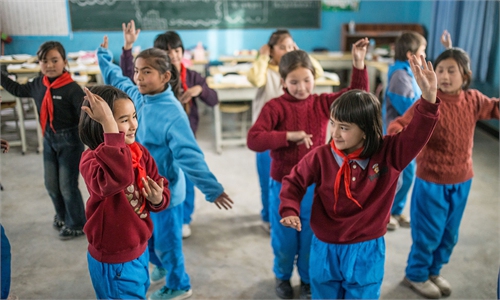Xizang to develop highland barley, yaks specialty industries, boost tourism to tap growth potential: political advisor

Monks attend an annual Buddha thangka displaying ritual at the Tsurphu Monastery in Southwest China's Xizang (Tibet) Autonomous Region. Photo: VCG
Southwest China's Xizang Autonomous Region recorded a GDP growth rate of 9.5 percent last year, the highest in the country. Riding on the momentum, the region is expected to sustain its robust economic recovery in 2024, boosted by the development potential in specialty industries such as highland barley and yaks.It will also step up basic infrastructure construction as well as local tourism, a Chinese national political advisor told the Global Times during the two sessions.Duoji Cizhu, a member of the National Committee of the Chinese People's Political Consultative Conference (CPPCC) and the president of the Xizang Federation of Industry and Commerce, said that Xizang enjoys a unique geographic advantage as it is an important passage connecting China with South Asia. The region could consider further high-level opening-up to facilitate the development of inbound and outbound tourism.
Last year, travel agencies in Xizang organized 23 outbound tourists group to Nepal, according to a report by media outlet chinanews.com.
Some deputies and political advisors also suggested Xizang should expand border trade with neighboring countries such as Nepal, which is Xizang region's largest trading partner and export market. Xizang and Nepal have inaugurated the jointly building of a China-Nepal industrial park in Nepal in 2019, which is also a key bilateral cooperation project under the Belt and Road Initiative (BRI). Xizang has also set up a border economic cooperation zone in Gyirong county.
In 2023, Xizang's foreign trade more than doubled to 10.98 billion yuan, local customs data showed. Its GDP expanded 9.5 percent last year, significantly higher than the national average of 5.2 percent. All those key indicators speak volume for the local economy vitality and a potential in development prospect.
"Xizang's basic infrastructure remains relatively undeveloped, so it is hoped that infrastructure building will gear up in 2024," Cizhu said.
Duan Xiangdong, a member of the CPPCC National Committee and the chairman of Aluminum Corp of China, said in addressing a proposal to the ongoing two sessions that the region, and in particular Ali prefecture, "a key area in China's opening-up to South Asia, which is also rich in natural and mineral resources," should double down on basic infrastructure investment, so that it is able to translate its resource advantages into economic dividends.
"The installed power grid capacity in Ali cannot meet rising electricity demand for social and economic development. Transportation in Ali is limited to highways, with no rail access, which is not cost-effective," Duan pointed out. He stressed that the development of the border regions is also conducive to ensuring national security.
Cizhu also serves as the president of Xizang business chamber. He envisioned that the private sector would play a more pivotal role in the development of overall local economy in 2024.
"Private enterprises in Xizang are set up by firms across the country, and they, while contributing to the improvements of people's livelihoods, also carry great significance in strengthening ethnic unity and the consolidation of border defense," he noted.
The work report of the Standing Committee of the 14th National People's Congress (NPC), China's top legislature, on Friday pledged to accelerate the formation of a law aimed at promoting the development of the private sector, sending a strong signal on policymakers' commitment to make continuous improvements in the business environment and boosting the high-quality development of the private sector for Chinese modernization.




